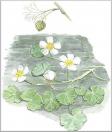Common Water Crowfoot - Ranunculus aquatilis
With its amazing carpet of flowers, the Common Water Crowfoot is on of the first wetland plants to announce the coming of spring. Its leaves differ profoundly in shape depending on their position: the floating leaves have wide blades, more or less incised and with toothed margins, whilst the submerged leaves are threadlike and look more like bundles of roots.
Many submerged plants have the latter type of leaf, because it has the advantage of offering the least possible resistance per biomass to the flow of the water yet as the same time providing the plant with the largest possible surface area in contact with the liquid medium, thus enabling gaseous exchange in a habitat relatively poor in oxygen and carbon dioxide.
The white five-petalled flowers are just the same as those of the congeneric terrestrial plants. Most of them emerge a few centimetres above the water and rely on insects for pollination; a more modest contingent, which remain closed under the water, resort to self-fertilisation.
The species is typical of lentic habitats (with slow moving water) rich in nutrient salts, which it often shares with the Thread-leaved Water Crowfoot (Ranunculus trichophyllus) - a waterweed without floating leaves. In more fast flowing, well oxygenated waters, its place is taken by the River Water Crowfoot (R. fluitans).
Like most Ranunculaceae (Buttercup Family) all parts of the Common Water Crowfoot contain toxic substances.




